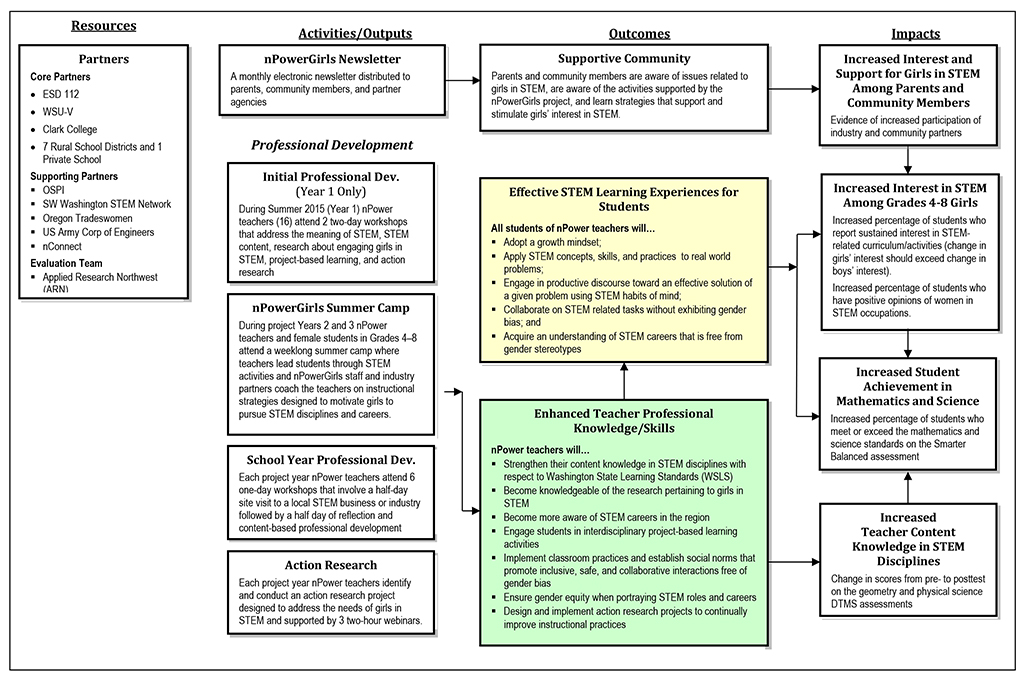Research to Practice, Practice to Research
nPower Girls
Empowering Female Students in STEM Through Teacher Professional Development and Community Connections
Connected Science Learning January-March 2019 (Volume 1, Issue 9)
By Vickei Hrdina, Sue Bluestein, Erin Harwood, Pamela M. M. Jull, and Alexander G. Dimitrov

In 2010 the American Association of University Women (AAUW) published Why So Few?, a research report that synthesized information on the dearth of women in STEM-related fields, and provided concrete recommendations for supporting and retaining females in STEM (science, technology, engineering, and math). Despite enormous gains in the last 50 years and considerable attention from the media and informal education sector, the fraction of women in STEM careers rests at about 24% in the United States. Among the reasons cited for this gap are girls’ self-perceptions of their abilities in math and science, and the lack of exposure to successful female role models in STEM. Although most assessment data show that performance in math and science is relatively equal between boys and girls, “girls are less likely than boys to interpret their academic successes in math and science as an indication that they have the skills necessary to become a successful engineer or computer scientist” (Hill, Corbett, and St. Rose 2010, p. 7). Programs abound that aim to involve young women in STEM subjects; most of these, however, are afterschool and summer programs, which can inadvertently marginalize students in poverty and students from rural and isolated communities (Afterschool Alliance 2016). In contrast, our project targeted teachers’ classroom instructional strategies to impact all students, with a focus on strategies to benefit girls. The program also connected teachers with science practitioners in the local STEM business community and formal science educators to create authentic STEM learning contexts.
In 2015 we administered a needs assessment survey to seven rural, isolated, and/or high-needs school districts that span southwestern Washington, from the Columbia River Gorge to the industrial ports of the Columbia River. The results show that there are few or no opportunities for girls to engage in STEM after school or in the summer. Although teachers from these districts report attending math and science professional development, they also report that a focus on STEM disciplines was fragmented at best. All administrators who took the survey agreed that resources are generally designated to programs not dedicated to STEM and certainly not those that target inclusion for young women. Student responses on this needs assessment were even more startling: More than 50% of respondents reported that in math and science classes, instruction is targeted toward male students, and 43% of girls surveyed report that they would not consider taking advanced courses in math or science. Although female students find computer science “fascinating,” there were few opportunities to learn more about the topic or consider a pathway for a potential career. Missing opportunities to develop STEM habits of mind and investigate careers in upper elementary and middle school make it very difficult for students to perceive themselves as part of a STEM career pathway later in high school or college (Neuhauser 2015; Samet and Kekelis 2016).
The project nPower Girls, funded by a Mathematics and Science Partnerships (MSP) grant from the U.S. Department of Education, aimed to address some of those issues by:
- strengthening teacher instructional practices that support female students’ learning in STEM;
- helping cultivate female students’ interest, confidence, and achievement in STEM opportunities and career paths; and
- focusing on the critical grades of 4–8, when many girls lose interest or feel discouraged from STEM subjects.
Empirically, the same practices were shown to be effective for boys as well (IES 2007).
Our school partners were from the same seven geographically isolated districts that completed the needs assessment, where professional learning and student opportunities to engage in STEM in real-world situations are extremely limited. To address this lack of access, nPower partnered with 18 local STEM industries to connect teachers to women working in STEM and help school educators learn about problems in science and industry that those companies address. In addition to the formal collaboration between Educational Service District 112 (ESD 112), Clark College, and Washington State University Vancouver (WSUV), which formed the nPower advisory panel, multiple community businesses and informal educators served as content experts, mentors, guest speakers, and workshop facilitators to provide meaningful learning contexts for teachers and students. The advisory panel was composed of a project director (ESD112 STEM director), ESD112 math specialist and science coordinator, Clark College STEM outreach coordinator (and biology faculty), Washington State University Vancouver mathematics and neuroscience faculty, and an external program evaluator (Applied Research Northwest).
Rationale
nPower Girls was grounded in the recommendations for supporting girls in STEM laid out in the AAUW publications Why so Few? (Hill, Corbett, and St. Rose 2010) and Solving the Equation (Corbett and Hill 2015), as well as the Institute of Education Sciences (IES) report Encouraging Girls in Math and Science (2007). The advisory panel chose to follow these three documents because they provide concrete examples for creating an equitable classroom and do not require systemic shifts or large capital investment in programs. The recommendations work equally well for all students and teachers, as they support the instructional shifts needed to effectively implement both the Common Core State Standards (CCSS) and the Next Generation Science Standards (NGSS), both adopted by Washington State. Our approach to STEM instruction delivered science content alongside the authentic integration of math, using technology and engineering as problem-solving methods.
Our initial planning phase led us to operationalize some of the recommendations that were common across the referenced reports (Table 1).
Table 1
Recommendations for supporting and encouraging girls in STEM
| IES 2007, pp. 9 and 11
|
|---|
| Hill, Corbett, and St. Rose 2010, pp. 90–91; Corbett and Hill 2015, pp. 105–106
|
AAUW also recommends that gender bias be acknowledged openly in the classroom and beyond, and that students should receive instruction on gender bias, as well as stereotype threat. One recommendation nPower teachers easily applied in their classrooms was to highlight the achievements of women in STEM-related careers. Examples included computer programmers, engineers, and physicists, but also women in the trades and other nontraditional female careers. One simple classroom solution involved images showing an equitable representation of women and men in various occupational roles that supersede traditional gender stereotyping. Our 18 school-year workshops exposed teachers to local STEM industries and career possibilities for their students, and highlighted how their instructional content applies to the real world. Teachers in the program expressed appreciation for these opportunities in postworkshop surveys, and many shared this information with their students immediately after the workshops.
Theory of action
During the 2014–15 school year, a pilot of nPower Girls was launched with 20 math and science teachers to test the methodology and further develop the theory of action. The advisory panel met for an initial two-day planning session, with support from the Washington State Math–Science Partnership team, to articulate the program’s logic model and theory of action (see Figure 1), and plan the initial learning progression for the first year of the program. From this point and throughout the duration of the three-year project, the advisory panel met monthly for over three years prior to all teacher professional learning sessions to coplan each workshop. Each member of the advisory panel contributed his or her unique expertise, including extensive knowledge of CCSS Mathematics– and NGSS-aligned instruction. Members of the advisory panel cofacilitated each professional learning session (with the exception of the evaluator, who conducted observations and interviews, reported findings to teachers, and supported action research methodology). The project director led the development of the business and community partnerships, with the support of the Southwest Washington STEM Network.
To assist teachers in creating a “classroom environment that sparks initial curiosity and [fosters] long-term interest in math and science” (IES 2007, p. 23), the nPower advisory panel chose to use project-based learning (PBL) as an instructional method. PBL provides students with appropriate and relevant contexts for learning by connecting their learning to the community and real-world issues. PBL as an instructional framework is well-researched (Condliffe et al. 2017).
For the purposes of this project, the advisory panel closely examined Jo Boaler’s (1997) work on equity and student engagement in mathematics, due to the high number of math teachers we were working with who had significant experience and comfort in nontraditional math instruction. The advisory panel also reviewed literature on student motivation and engagement to address program teachers’ concerns about developing students’ critical thinking, sustained inquiry, and student agency in their learning (Ladewski, Krajcik, and Harvey 1994; Hixson, Ravitz, and Whisman 2012). Because of its reputation in the field of PBL and the free and open tools and resources it has made available, the advisory panel selected the Buck Institute for Education’s Gold Standard Criteria for PBL as its pedagogical framework. PBL supports the intentional integration of 21st-century skills such as collaboration, communication, and creative thinking (Hixson, Ravitz, and Whisman 2012). These skills support females in recognizing their “career-relevant skills” (Hill, Corbett, and St. Rose 2010, p. 7), and allow students to expand their perception beyond the idea that academic success is the only predictor of success in STEM careers. PBL has also been shown to provide more relevant learning and engage students’ hearts and minds, resulting in a sustained level of interest (Thomas 2000; Walker and Leary 2009).
Another component to our theory of action included engaging teachers in action research each school year. As defined in Sagor 1992, action research is “a disciplined process of inquiry conducted by and for those taking the action.” Action research in educational settings is intended to contribute to the knowledge base on pedagogical issues, as well as to allow teachers to gain useful insight about their own work (Sagor 1992, p. 7). By engaging in action research as they implemented the research-based recommendations outlined here within their classroom, teachers had the opportunity to document impacts resulting from their instructional changes. In clearly tracking these changes, they could see for themselves what worked and what did not.
We believed that engaging students in PBL and having nPower teachers complete action research on their methods would improve teacher practice and, correspondingly, student achievement. Our complete theory of action is described in Figure 1.
Professional learning model
Our professional learning model was structured around direct connection with our business and community partners. Each project year, nPower teachers attended six one-day workshops spread uniformly through the school year that involved a half-day site visit to a local STEM business or industry, followed by a half day of reflection and content-based professional development. For professional development, the advisory panel chose a sample STEM activity that supported the content explored during the industry visit, and modeled a subset of instructional practices as teachers engaged with the STEM activity lesson. Each year, the teachers were faced with a specific driving question and a selection of local businesses to help address it. Here we report mainly the details from Year 1.
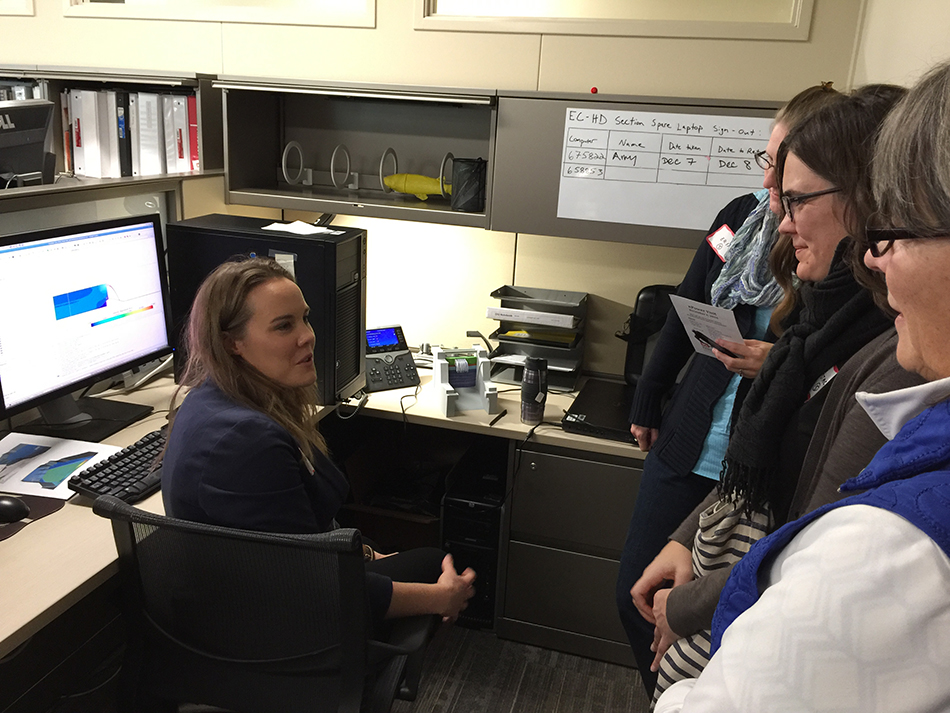
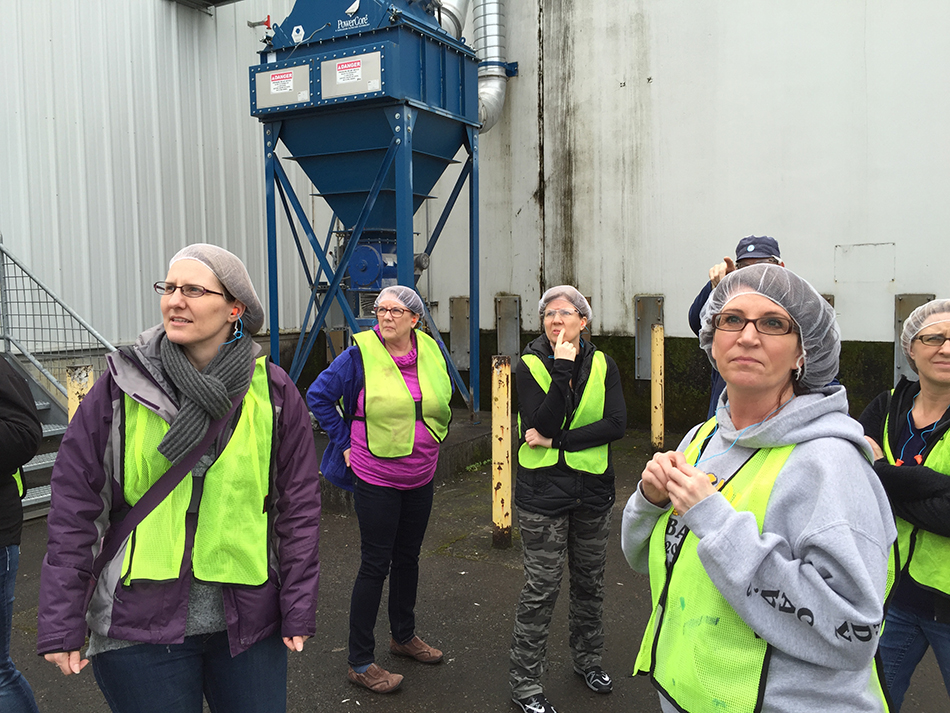
To model PBL in year 1, the advisory panel selected the driving question, “Should Washington industries be required to use renewable energy?” (see Table 2 for other years’ driving questions). We engaged a federal nonprofit power marketing administration, manufacturers of plastic-coated cardboard boxes, our local public utility, a community college with a degree program for renewable energy technology, and a nonprofit wind energy community education group. Through these partnerships, teachers were exposed to multiple women and men working in STEM-related fields in our local community: mechanical and electrical engineers, meter readers, line maintenance workers, software programmers, factory quality control officers, and an air quality engineer. Each of these professionals helped clarify the STEM jobs available in our local community, the skills necessary to fill these positions, and how each job relates to understanding energy, power, and manufacturing on a regional level. Teachers remarked that after each site visit they left with firsthand information on local STEM careers to share with their students. Many shared their photos and video, and several invited our community partners into the classroom or reached out to develop their own local partnerships, providing students with successful role models in STEM careers. Those images are available in the companion supplementary file.
Table 2
nPower Girls driving questions by year
| Year 1 | Should Washington industries be required to use renewable energy? |
|---|---|
| Year 2 | How can we use computer science to model Earth systems interactions? |
| Year 3 | STEM in strange places: Where are the unlikely STEM jobs in southwest Washington? |
To extend the learning of the morning site visit, math and science teachers participated in integrated, content-based activities involving at least two STEM disciplines during the afternoon sessions. Because our project included elementary, middle, and high school teachers of math and science, it was important to our project that we showcase interdisciplinary approaches to content. For each workshop, the advisory panel focused its attention on a particular recommendation for girls in STEM, and teachers had the opportunity to reflect on potential classroom implications. For example, following a visit to our local public utility to learn about a large solar installation and jobs related to solar energy, teachers spent the afternoon engineering a solar water heater that could achieve the highest efficiency. During the activity, nPower staff observed as teachers worked, noting teacher remarks such as, “This is really hard” or “I’m not sure if we will be able to figure this part out.” Once the activity was completed, the quotes were posted anonymously and teachers were asked to craft informational feedback statements that they might use with students in their classroom. For example, to respond to statements such as, “I don’t think we’re going to be able to make this work,” teachers responded with feedback including, “You’ve done a great job of working within your constraints here. Let’s look back at your design from the beginning and see if we can identify where the problem might be.”
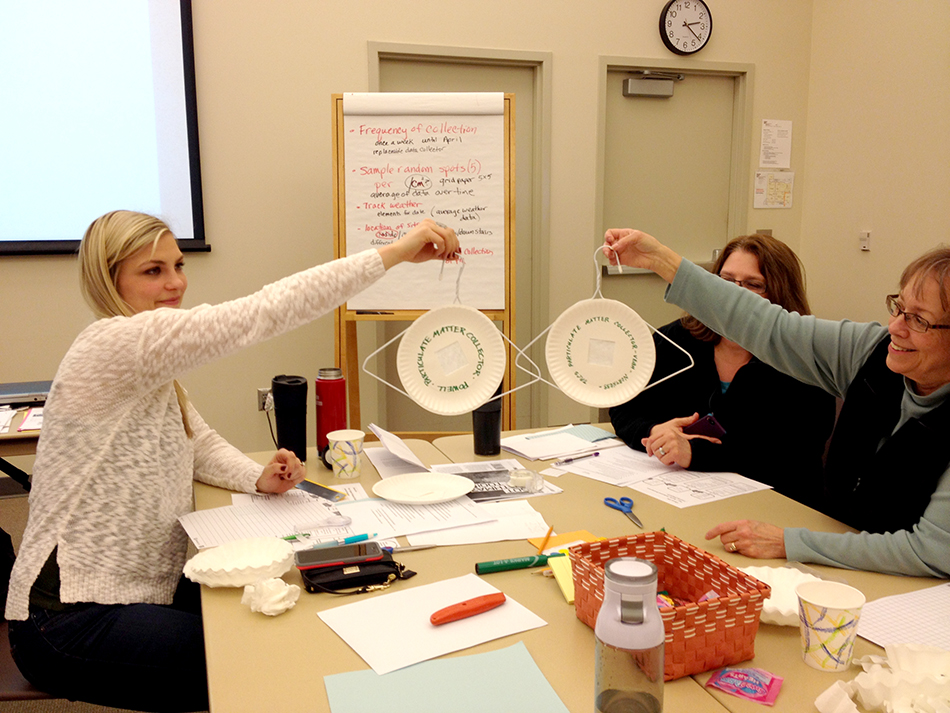
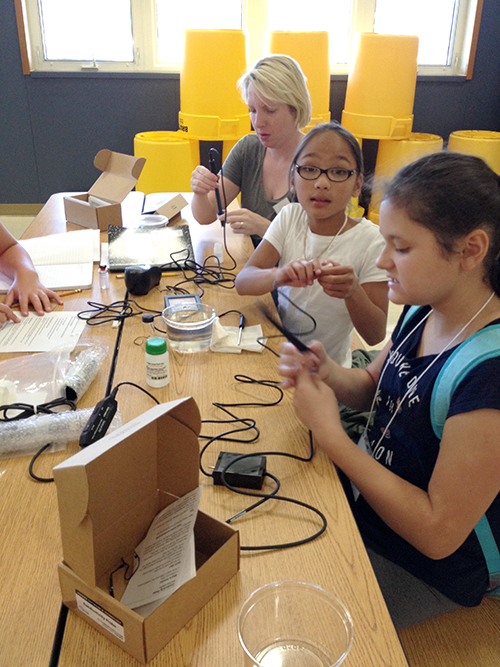
Each workshop focused on connecting PBL to the morning industry/community partner visits and to the overarching driving question that we collectively sought to answer throughout the school year. Many teachers in the first year began experimenting with PBL in their classrooms by adapting instructional materials modeled during our workshops. One teacher revised a manufacturing technology problem to engage students in creating their own candy packaging plant, developing nets (blueprints) as the basis for the packing operation and presenting their design to the “board” of the company that hired them. The application of geometry, spatial intelligence, and engineering design in this particular PBL experience is a demonstration of the integrated and applied instruction that was an aim of our project. This teacher and her students also reached out to a national candy company to share their project and results, and were thrilled to receive a response from the company honoring the students’ work. Authentic outreach to a national company helped students hone their communication abilities, one of the core 21st century-skills key to success in STEM fields.
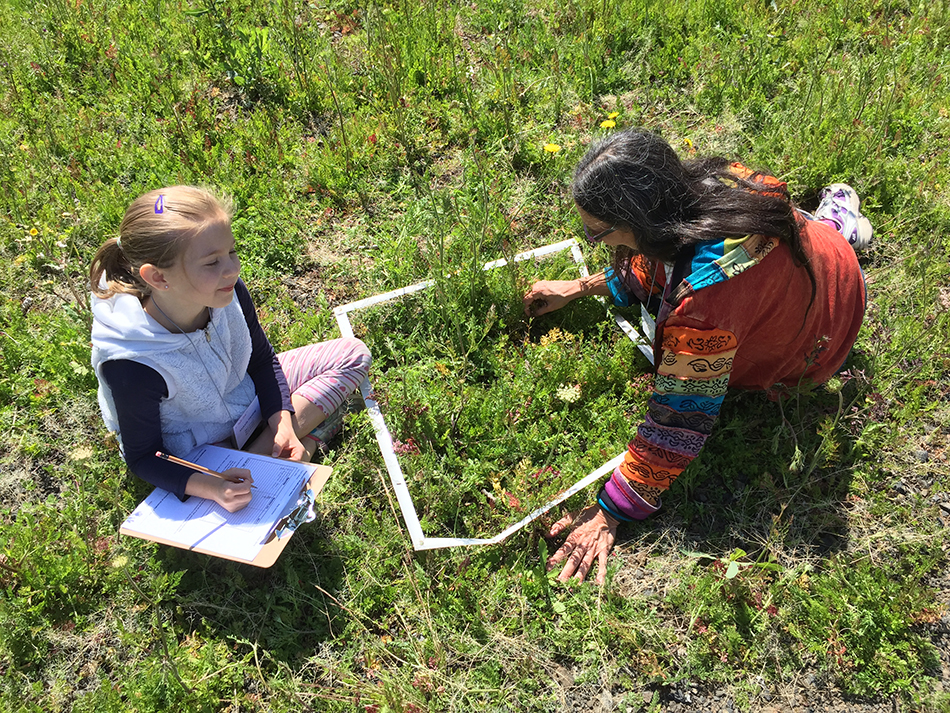
Additionally, summer camps allowed teachers to participate with their students as they engaged in integrated STEM activities, putting to the test teachers’ often-voiced perception that “this won’t work with my students.” The first summer camp was developed by the advisory panel and STEM business partners; all nPower teachers participated in the camp with 16 of their own female students to learn together. They focused on a new STEM driving question: “How can we use STEM to understand the health of the local ecosystem?”
Camp nPower addressed the goals of the overall project in several ways. First, teachers in the project had the opportunity to practice all the recommendations from the Why so Few? (Hill, Corbett, and St. Rose 2010) and Encouraging Girls in Math and Science (IES 2007) reports in an all-female, out-of-school setting (Table 1). This allowed teachers to focus explicitly on how female students interact with STEM PBL. We asked the teachers to take themselves out of the role of teacher and pressed them to learn alongside the girls, and do their best to allow students autonomy in decision-making and exploring solutions to some of the problems investigated. Stepping out of their traditional role proved challenging for many teachers and became a point of self-reflection for them during the second program year.
Second, Camp nPower was meant to provide a model of a STEM out-of-school experience that partnered with informal educators and community businesses as content experts. Project staff devised the driving question for the three-day camp, and recruited community and informal STEM educators to deliver instructional activities on:
- Biological field work (species inventory and indexing, water quality testing, tree abundance surveys)
- Engineering design challenges (toxic waste cleanup, stormwater runoff mediation, water pollution)
- Computer science applications (using Code.org’s Project GUTS to model and simulate interactions within ecosystems)
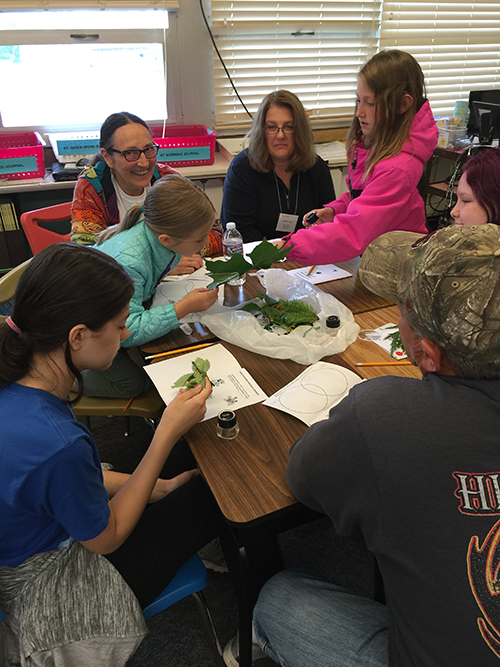
This structure not only supports the intentions of the NGSS to engage students in authentic problem-solving situations, but also demonstrates how to make the local STEM community play a stronger role in collaborating with teachers and schools in out-of-school contexts. Many teachers in the program commented that this experience helped them understand how to connect with local outreach programs, such as county offices of conservation, to bring STEM-related careers and content-driven experiences into the classroom. These relationships build a strong sense of social capital in STEM careers for both teachers, and by proxy, their students.
Lastly, students who live in our rural Washington communities are unlikely to have afterschool and summer programs available to them that directly relate to STEM or target female students. This was a driving factor in the development of the summer camps. We were creating an example for these small rural schools to build an out-of-school STEM experience in partnership with their community. During the second and third years of our program, we broadened our business and industry connections to include STEM careers (often nontraditional) that are part of the rural, isolated communities where our teachers and their students reside.
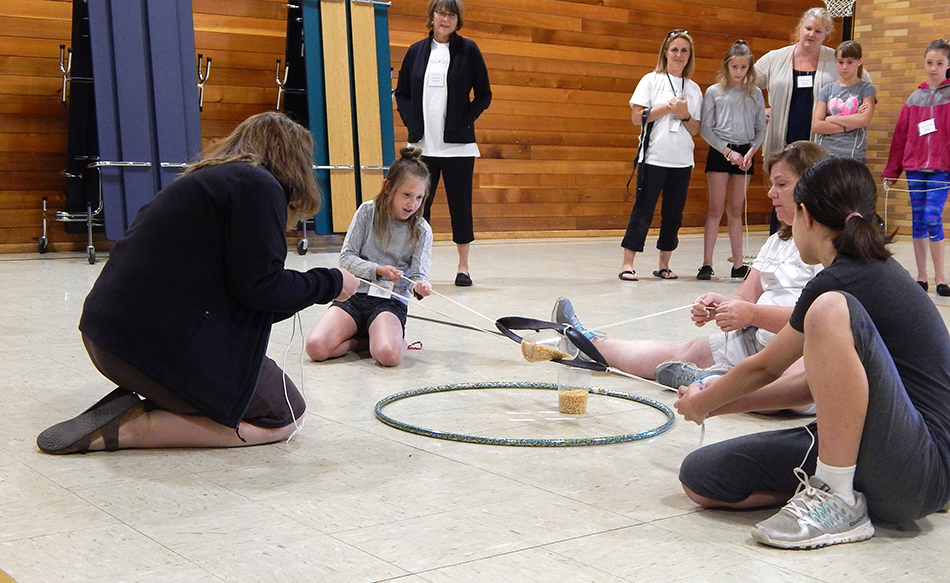
Project evaluation instruments and summary of results
In year 1 of the program, the advisory panel conducted a review of existing instruments measuring student interest in STEM and selected the Friday Institute’s Student Attitudes Toward STEM (S-STEM) instrument (2012) as the best fit for the nPower project. This 26-item survey provides a 5-point Likert scale of agree–disagree responses to attitudes toward math, science, engineering, and technology, with scores ranging from 26 to 130. The survey was piloted with 154 students in spring 2015. The results showed good variability in student responses, suggesting our survey would likely produce reliable measures of change over time. However, in the subsequent pre–post administration to students in the project (n = 179), none of the students’ matched scores changed significantly (Tpaired = 0.466, p = 0.321). In fact, nearly as many students showed reduced interest in STEM as those showing increased interest in STEM (n = 86 and 87, respectively; six students showed no change in their scores). Similarly, there were no significant changes within the individual sections (math, science, engineering). Analysis found no differences by gender. Within schools we saw no significant change, with one exception: A tiny, rural school with only five students demonstrated increased interest in engineering (30.6–38.8) and students’ overall interest in STEM increased by nine points on the 130-point scale (Tpaired = 1.758, p = 0.040). We discussed the findings with teachers and were able to determine that although the instrument may be reliable, it was probably unable to detect the kinds of changes in STEM interest that were being produced in the classroom. To better capture those, we turned to teacher reports of student behavior.
In spring 2017 teachers involved in the nPower Girls grant project completed a self-assessment of the program components in their classrooms. The purpose of the assessment was to verify teachers’ fidelity in using key skills to enhance student learning of STEM-related content and build student interest in STEM, and to determine whether there are opportunities for program leaders to provide additional support in areas where teachers struggle (see Figure 2). The rubric was developed based on teacher and program leader discussions focusing on mastery of implementation of the program components. Twelve teachers of the cohort of 20 completed the self-assessment. The other eight did not, as they had not participated in the full project.
Teachers rated their student behavior based on 18 items across four domains. The domains asked teachers to assess whether students:
- exhibit characteristics of a growth mindset.
- use 21st-century skills to apply STEM concepts to real-world problems.
- collaborate equitably toward solutions of STEM problems.
- display understanding of STEM careers.
Items were ranked by average scores (range 1–3, with 1 = rarely/never, 2 = sometimes, 3 = often).
Teachers gave exceptionally high marks to their students on two items, both relating to the first domain, promotion of a growth mindset; being able to teach students that academic skills are expandable and improvable required understanding of students’ growth mindset. The two items were:
- Students exhibit excitement about new projects.
- Students show willingness to take chances by trying new methods.
Lower marks were given for four items—two relating to promotion of a growth mindset and two pertaining to use of 21st-century skills to apply STEM concepts to real-world problems. The low scores suggest that these student behaviors were either hard for teachers to support or that they were somewhat out of scope for the training that had been presented. The four items were:
- Students propose possible extensions to the project.
- Students are self-reliant and understand the expectations of the project.
- Students are engaged in critical thinking. They develop their own higher-level questions about real-world problems and discuss relevance.
- Students self-assess with standards (formative and summative).
Teachers gave moderately high marks to all items in the final two domains.
Figure 2
Teacher fidelity of implementation self-assessment results: highest and lowest items pertaining to students (n = 12)
See Resources for the full data and graphic representation (Table S1 and Figure S1). 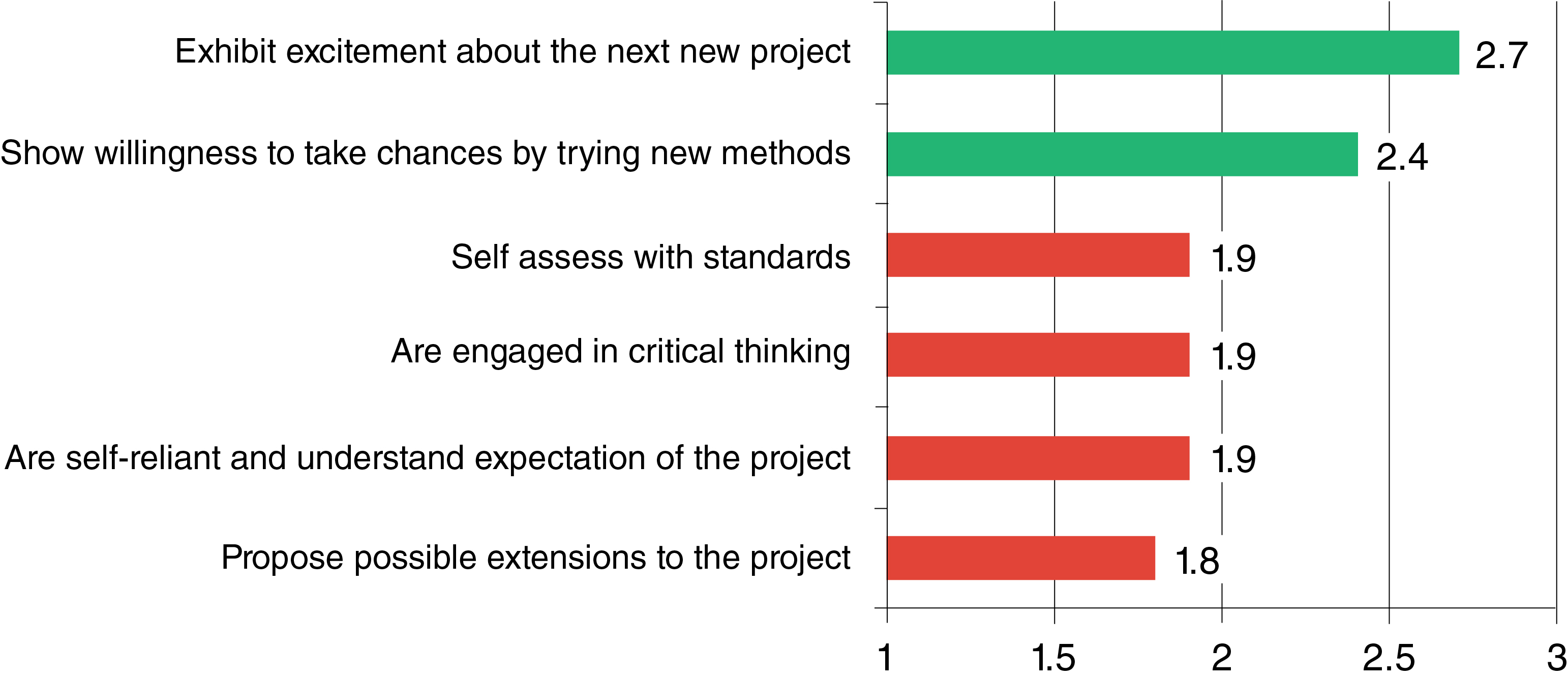
Objective data about students’ growth mindset were also developed for the nPower Girls project. nPower program teachers collected baseline and subsequent data on their students using a Growth Mindset survey, developed by Carol Dweck (2008). This calibrated survey tool provides scores from 0 to 65, and were classified, according to Dweck, in this way:
- Score 0–20 = strong fixed mindset
- Score 21–33 = predominantly fixed mindset with some growth ideas
- Score 34–44 = growth mindset with some fixed ideas
- Score 45–65 = strong growth mindset—a belief that everything is achievable through added effort
In each of the program years in which the Growth Mindset survey was administered, students showed significant growth (p < 0.05; see Table 3).
Table 3
Student growth mindset test scores
| 2015–16 school year (n = 261) | |
|---|---|
| Pretest score | Post-test score |
| 39.93 | 41.09 |
| 2016–17 school year (n = 78) | |
| Pretest score | Post-test score |
| 38.59 | 40.22 |
| *Change is significant at p < 0.05 | |
The most sizeable shifts occurred among students with a predominantly fixed mindset; in spring 2017 44% of these students improved to a growth mindset with some fixed ideas, and 19% sprung up two levels to a strong growth mindset.
In each administration of test, students most often fell into the category of having demonstrated a growth mindset with some fixed ideas (47–66% of matched cases). The most commonly held fixed ideas were primarily about personality and character, rather than learning or intelligence:
- You can do things differently, but the important parts of who you are can’t really be changed.
- You are a certain kind of person, and there is not much that can be done to really change that.
- Some people are good and kind, and some are not—it’s not often that people change.
These findings are particularly interesting, as much of the data collected on why female students do not select STEM-related career and course pathways have more to do with perception of self and socially constructed realities than actual ability.
Conclusions
There is a lot to celebrate in the nPower Girls MSP program. Teacher testimony shows that teachers are thinking differently and working hard to engage kids in meaningful ways that do not inadvertently disenfranchise girls. Using PBL as a mechanism has been challenging yet productive, and the corps of teachers engaged in PBL were very enthusiastic about its impact on their student engagement. Incorporating action research has helped them become more intentional about their teaching and lesson development.
Overall, the most significant learning from nPower Girls was the overwhelming growth in direct partnership between local STEM businesses and public education. Over the three years, we have refined and articulated our shared vision and goals with the Southwest Washington STEM Network, and the network uses nPower Girls as a model of authentic collaboration between business and K–12 education. The project staff have developed mini-externship planning templates, structured questions for panelists and interviews, and built a teacher postvisit reflection tool that is currently the focus of a three-hour online learning module to share the concept with other education leaders (see Supplementary Resources for more information about the module). It is our hope that more regional service agencies and STEM networks will develop similar content-driven learning opportunities to foster collaboration on real-world problems for students to solve in the context of STEM instruction across the state, the nation, and beyond.
Vickei Hrdina (vickei.hrdina@esd112.org) is STEM director at Educational Service District 112 in Vancouver, Washington. Sue Bluestein (sue.bluestein@esd112.org) is math specialist at Educational Service District 112 in Vancouver, Washington. Erin Harwood (eharwood@clark.edu) is STEM outreach coordinator at Clark College in Vancouver, Washington. Pamela M. M. Jull (pamela.jull@arnorthwest.com) is president of Applied Research Northwest in Bellingham, Washington. Alexander G. Dimitrov (alex.dimitrov@wsu.edu) is associate professor of mathematics and neuroscience at Washington State University Vancouver in Vancouver, Washington.
Careers STEM Informal Education



